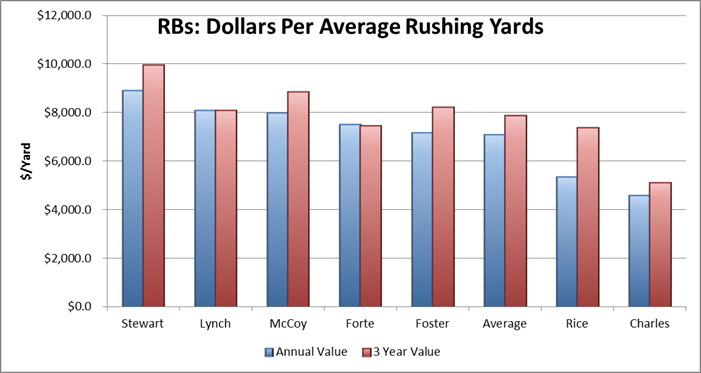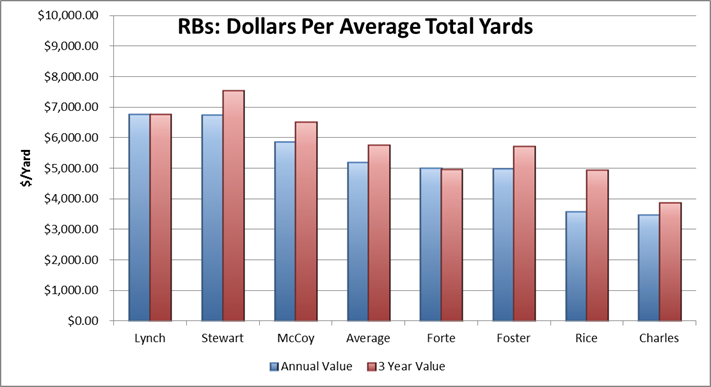[adsenseyu1]
While we already have discussed the Marshawn Lynch contract on the site in the past I thought in light of his holdout that we could use this as an opportunity to look at certain distinctions between contract situations. On it’s face the immediate reaction to Lynch holding out is that Jamaal Charles got a raise and thus the Seahawks should follow the pattern to give Lynch what he deserves. However, the two contract situations are very different.
Charles was underpaid during the term of his agreement. Based on his production at the time of signing (which was more or less near the end of the 2010 season) the Chiefs got a tremendous bargain. The fact that he produced at an even higher level in the future made it even more of a bargain. For the most part Charles was giving the Chiefs $10 million a year production at 55% of the cost.
Lynch was paid very well upon signing his contract in 2012. The Seahawks follow a different contract model than many other teams. Many of their contracts appear to be very forward looking rather than using the past as a guide for future performance. Whether it was Percy Harvin, Zach Miller, Sidney Rice, or a number of other players on their team, they often try to identify the future benefits they will realize once the player is fully immersed in their system. Lynch is one of those players.
Lynch began his career in Buffalo and fell out of favor in 2009. During the 2010 season he was traded to the Seahawks and had a relatively lackluster run averaging 3.5 yards per carry and producing 573 yards in 12 games. Lynch would have a much better season in 2011 running for 1,200 yards on a 4.2 YPC as he looked for a contract in free agency.
I like to use a matrix on valuing contracts (and there are plenty of other ways to do this) where we use a weighted average of three years of stats to help identify a range of pay. I usually split the numbers 50/35/15. Lynch signed in the same offseason as many other players. I included Charles in the list as comparison even though he signed in 2010. Here were the numbers leading into the contracts signed by the player:
| Player | Age | Att | Yds | YPC | TD | Rec | Yds | YFS | YPT |
| Rice | 25 | 291.1 | 1309.9 | 4.50 | 8.8 | 71.8 | 651.9 | 1961.8 | 5.41 |
| Foster | 26 | 261.6 | 1216.2 | 4.65 | 11.1 | 50.8 | 533.9 | 1750.0 | 5.60 |
| Charles | 25 | 191.6 | 1179.1 | 6.16 | 5.0 | 40.6 | 378.8 | 1557.8 | 6.71 |
| McCoy | 24 | 232.2 | 1128.1 | 4.86 | 11.6 | 57.3 | 410.9 | 1539.0 | 5.32 |
| Forte | 27 | 223.2 | 1012.0 | 4.54 | 4.2 | 52.4 | 507.1 | 1519.1 | 5.51 |
| Lynch | 26 | 231.2 | 927.5 | 4.01 | 8.4 | 25.9 | 183.6 | 1111.1 | 4.32 |
| Stewart | 25 | 166.5 | 820.0 | 4.93 | 4.2 | 29.0 | 263.4 | 1083.4 | 5.54 |
In terms of production Lynch was near the bottom, only better than Jonathan Stewart. In terms of per play performance Lynch was at the bottom of the list and was also one of just two players to be a non-factor in the passing game.
One of the ways we can break down the valuation on the contract is by looking at the annual value and the three year contract average value per rushing yard and yard from scrimmage. This tells us what the player would have cost, in an average year, per yard of production.
[adsenseyu2]
So when you look at Lynch what you see is a player who was compensated, at the very least, fairly over the terms of his original contract. On an annual basis he was more or less compensated at the top of the position (discounting Adrian Peterson and Chris Johnson’s outlier deals). That was balanced out somewhat by the cash flows of the contract which were steady rather than frontloaded like Rice, Foster, and McCoy, but it was still a contract that called for a high level of salary based on what he had done before. Due to the lack of expected receiving production he would likely have been a player that a team would have required a partner for passing downs.
As things turned out the Seahawks were correct in their projections and Lynch was worth the risk, but it was one of the better player contracts in the NFL. He was also guaranteed $17 million right from the start, higher than all but two players on this list, both of whom signed longer contracts.
That’s why it is hard to compare the situation of the Charles and Lynch and expect the same results, even just on the principle of “fairness”. Charles was the most underpaid of the group. If the Seahawks took an optimistic eye with Lynch, then the Chiefs took a super pessimistic one with Charles. Even if we factor in Charles’ new money ($5 million) into the deal, he would simply come up to the Forte/Rice levels on annual value per run yard and still be the lowest paid using total yards from scrimmage as a metric.
While its understandable that Lynch is holding out, Charles was far more deserving of the raise he received. In Lynch’s case, his improved performance was built into the contract he signed in 2012. We’ll see if Seattle budges, but this is a spot where the fans may not be on the player’s side
[adsenseyu4]
[adsenseyu2]
[subscribe2]

